Students can Download Tamil Nadu 12th Economics Model Question Paper 5 English Medium Pdf, Tamil Nadu 12th Economics Model Question Papers helps you to revise the complete Tamilnadu State Board New Syllabus and score more marks in your examinations.
TN State Board 12th Economics Model Question Paper 5 English Medium
General Instructions:
- The question paper comprises of four parts.
- You are to attempt all the parts. An internal choice of questions is provided wherever applicable.
- All questions of Part I, II, III and IV are to be attempted separately.
- Question numbers 1 to 20 in Part I are Multiple Choice Questions of one mark each.
These are to be answered by choosing the most suitable answer from the given four alternatives and writing the option code and the corresponding answer - Question numbers 21 to 30 in Part II are two-mark questions. These are to be answered in about one or two sentences.
- Question numbers 31 to 40 in Part III are three-mark questions. These are to be answered in above three to five short sentences.
- Question numbers 41 to 47 in Part IV are five-mark questions. These are to be answered in detail Draw diagrams wherever necessary.
Time: 3.00 Hours
Maximum Marks: 90
PART – I
Choose the correct answer. Answer all the questions: [20 × 1 = 20]
Question 1.
Identify the flow variable.
(a) money supply
(b) assets
(c) income
(d) foreign exchange reserves
Answer:
(c) income
Question 2.
Economic planning is an important feature of Economy………..
(a) Mixed
(b) Capitalism
(c) Socialism
(d) Traditional
Answer:
(a) Mixed
Question 3.
The financial year in India is…………
(a) April 1 to March 31
(b) March 1 to April 30
(c) March 1 to March 16
(d) January I to December 31
Answer:
(a) April 1 to March 31
![]()
Question 4.
Match the following and choose the correct answer by using codes given below:

Code:
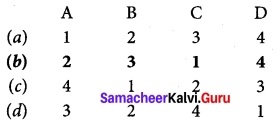
Answer:
(b) A-2, B-3, C-1, D-4
Question 5.
Aggregate supply is equal to…………
(a) C + I + G
(b) C + S + G + (x – m)
(c) C + S + T + (x – m)
(d) C + S + T + Rf
Answer:
(d) C + S + T + Rf
Question 6.
……….. means that persons who are willing to work and able to work must have employment or a job.
(a) Full employment
(b) Unemployment
(c) Educational unemployment
(d) Seasonal unemployment
Answer:
(a) Full employment
Question 7.
The average propensity to consume is measured by
(a) C/Y
(b) C × Y
(c) Y/C
(d) C + Y
Answer:
(a) C/Y
Question 8.
Additional investment that is independent of income is called…………
(a) Autonomous Investment
(b) Autonomous Consumption
(c) Average Investment
(d) Marginal Investment
Answer:
(a) Autonomous Investment
Question 9.
Money is ……….
(a) acceptable only when it has intrinsic value
(b) constant in purchasing power
(c) the most liquid of all assets
(d) needed for allocation of resources
Answer:
(c) the most liquid of all assets
Question 10.
Match the following and choose the correct answer by using codes given below:

Code:
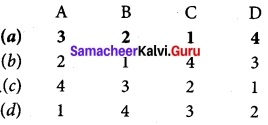
Answer:
(a) A-3, B-2, C-1, D-4
Question 11.
NABARD was set up in…………
(a) July 1962
(b) July 1972
(c) July 1982
(d) July 1992
Answer:
(c) July 1982
Question 12.
Open Market operations enable the ………….. to reduce the money supply in the economy.
(a) Commercial bank
(b) SBI
(c) ICICI
(d) RBI
Answer:
(d) RBI
![]()
Question 13.
Exchange rate for currencies is determined by supply and demand under the system of…………
(a) Fixed exchange rate
(b) Flexible exchange rate
(c) Constant
(d) Government regulated
Answer:
(b) Flexible exchange rate
Question 14.
Which of the following is correctly matched:
(a) David Ricardo – Factor Endowment Theory
(b) Eli Heckscher – British Economist
(c) Marshall – Swedish Economist
(d) Adam Smith – Theory of Absolute cost advantage
Answer:
(d) Adam Smith – Theory of Absolute cost advantage
Question 15.
Which of the following is not the member of SAARC?
(a) Pakistan
(b) Sri Lanka
(c) Bhutan
(d) China
Answer:
(d) China
Question 16.
Objectives of WTO are……..
(i) To ensure reduction of tariff and other barriers.
(ii) Low level of standard of living.
(a) Both (i) and (ii) are true
(b) Both (i) and (ii) are false
(c) (i) is true but (ii) is false
(d) (i) is false but (ii) is true
Answer:
(c) (i) is true but (ii) is false
Question 17.
The direct tax has the following merits except……….
(a) equity
(b) convenient
(c) certainty
(d) civic consciousness
Answer:
(b) convenient
Question 18.
The major contributor of Carbon monoxide is……….
(a) Automobiles
(b) Industrial process
(c) Stationary fuel combustion
(d) None of the above
Answer:
(a) Automobiles
Question 19.
Sarvodaya Plan was advocated by
(a) Mahatma Gandhi
(b) J.P. Narayan
(c) S. N Agarwal
(d) M.N. Roy
Answer:
(b) J.P. Narayan
Question 20.
To restructure the planning process into a bottom-up model is called
(a) Decentralized planning
(b) Scenario planning
(c) Partial planning
(d) Comprehensive planning
Answer:
(a) Decentralized planning
PART – II
Answer any seven question in which Question No. 30 is compulsory. [7 x 2 = 14]
Question 21.
What is meant by an ‘Economy’?
Answer:
An economy is referred to any system or area where economic activities are carried out. Each economy has its own character. Accordingly, the functions or activities also vary. An economy, the fundamental economic activities are production and consumption.
Question 22.
Define GDP deflator.
Answer:
GDP deflator is an index of price changes of goods and services included in GDP. It is a price index which is calculated by dividing the nominal GDP in a given year by the real GDP for the same year and multiplying it by 100.
GDP deflator = \(\frac{nominal GDP}{real GDP}\) × 100
![]()
Question 23.
Write the headlines of difficulties in Measuring National Income.
Answer:
Difficulties in Measuring National Income:
- Transfer payments
- Difficulties in assessing depreciation allowance
- Unpaid services
- Income from illegal activities
- Production for self-consumption and changing price
- Capital Gains
- Statistical problems
Question 24.
What are the components of aggregate supply?
Answer:
Aggregate supply has the following components:
- Aggregate (desired) consumption expenditure (C)
- Aggregate (desired) private savings (S)
- Net tax payments (T) (Total tax payment to be received by the government minus transfer payments, subsidy and interest payments to be incurred by the government) and
- Personal (desired) transfer payments to the foreigners (Rf) (eg. Donations to international relief efforts)
Question 25.
What do you mean by propensity to consume?
Answer:
The consumption function or propensity to consume refers to income consumption relationship. It is a “functional relationship between two aggregates viz., total consumption and gross national income.”
Symbolically, the relationship is represented as C = f (Y)
Where, C = Consumption; Y = Income; f = Function
Thus the consumption function indicates a functional relationship between C and Y, where C is the dependent variable and Y is the independent variable, i.e., C is determined by Y. This relationship is based on the ceteris paribus (other things being same) assumption, as only income consumption relationship is considered and all possible influences on consumption are held constant.
Question 26.
Write Fisher’s Quantity Theory of money equation.
Answer:
The general form of equation given by Fisher is MV = PT. Fisher points out that in a country during any given period of time, the total quantity of money (MV) will be equal to the total value of all goods and services bought and sold (PT)
MV = PT
Question 27.
What are the credit control measures?
Answer:
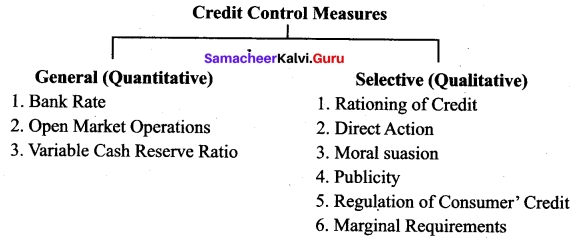
Question 28.
Specify any two affiliates of World Bank Group.
Answer:
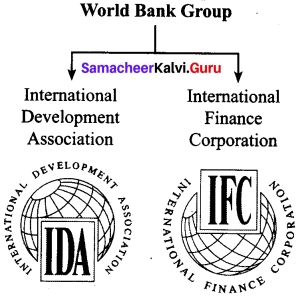
Question 29.
Specify the meaning of seed ball.
Answer:
- A seed ball (or seed bomb) is a seed that has been wrapped in soil materials, usually a mixture of clay and compost, and then dried.
- Essentially, the seed is ‘pre-planted’ and can be sown by depositing the seed ball anywhere suitable for the species, keeping the seed safely until the proper germination window arises.
- Seed balls are an easy and sustainable way to cultivate plants that provide a larger window of time when the sowing can occur.
Question 30.
What is GNP?
Answer:
Gross National Product (GNP):
GNP is the total market value of all final goods and services produced within a nation in a particular year, plus income earned by its citizens (including income of those located abroad), minus income of non-residents located in that country.
GNP is one measure of the economic condition of a country, under the assumption that a higher GNP leads to a higher quality of living, all other things being equal.
![]()
PART – III
Answer any seven question in which Question No. 40 is compulsory. [7 x 3 = 21]
Question 31.
Describe the different types of economic systems.
Answer:
There are three major types of economic systems. They are:
Capitalistic Economy (Capitalism):
- Capitalistic economy is also termed as a free economy (Laissez faire, in Latin) or market
economy where the role of the government is minimum and market determines the economic activities. - The means of production in a capitalistic economy are privately owned.
- Manufacturers produce goods and services with profit motive.
- The private individual has the freedom to undertake any occupation and develop any skill.
- The USA, West Germany, Australia and Japan are the best examples for capitalistic economies.
- However, they do undertake large social welfare measures to safeguard the downtrodden people from the market forces.
Question 32.
Classify the concepts of Macro Economics.
Answer:
The important concepts used in macro economics are presented below:
Stock and Flow Variables: Variables used in economic analysis are classified as stock and flow. Both stock and flow variables may increase or decrease with time.
Stock refers to a quantity of a commodity measured at a point of time. In macro economics, money supply, unemployment level, foreign exchange reserves, capital etc are examples of stock variables.
Flow variables are measured over a period of time. National Income, imports, exports, consumption, production, investment etc are examples of flow variables.
Economic Models A model is a simplified representation of real situation. Economists use models to describe economic activities, their relationships and their behaviour. A model is an explanation of how the economy, or part of the economy, works. Most economic models are built with mathematics, graphs and equations, and attempt to explain relationships between economic variables. The commonly used economic models are the supply-demand models and circular flow models and Smith models.
Question 33.
Write briefly about national income and welfare.
Answer:
National Income and Welfare:
National Income is considered as an indicator of the economic wellbeing of a country. The per capita income as an index of economic welfare suffers from limitations which are stated below:
- The economic welfare depends upon the composition of goods and services provided. The greater the proportion of capital goods over consumer goods, the improvement in economic welfare will be lesser.
- Higher GDP with greater environmental hazards such as air, water and soil pollution will be little economic welfare.
- The production of war goods will show the increase in national output but not welfare.
- An increase in per capita income may be due to employment of women and children or forcing workers to work for long hours. But it will not promote economic welfare.
Question 34.
What do you mean by aggregate demand? Mention its components.
Answer:
The aggregate demand is the amount of money which entrepreneurs expect to get by selling the output produced by the number of labourers employed. Therefore, it is the expected income or revenue from the sale of output at different levels of employment.
Aggregate demand has the following four components:
- Consumption demand
- Investment demand
- Government expenditure and
- Net Export (export – import)
Question 35.
Differentiate autonomous and induced investment.
Answer:
| SI.No | Autonomous Investment | Induced Investment |
| 1 | Independent | Planned |
| 2 | Income inelastic | Income elastic |
| 3 | Welfare motive | Profit Motive |
Question 36.
Explain the Trade cycle Depression.
Answer:
Depression:
- During depression the level of economic activity becomes extremely low.
- Firms incur losses and closure of business becomes a common feature and the ultimate result is unemployment.
- Interest prices, profits and wages are low.
- The agricultural class and wage earners would be worst hit.
- Banking institutions will be reluctant to advance loans to businessmen.
- Depression is the worst phase of the business cycle.
- Extreme point of depression is called as “trough”, because it is a deep point in business cycle.
- Any person fell down in deeps could not come out from that without other’s help.
- Similarly, an economy fell down in trough could not come out from this without external help.
- Keynes advocated that autonomous investment of the government alone can help the economy to come out from the depression.
Question 37.
Explain the Net Barter Terms of Trade.
Answer:
1. Net Barter Terms of Trade:
This type was developed by Taussig in 1927. The ratio between the prices of exports and of imports is called the “net barter terms of trade’. It is named by Viner as the ‘commodity terms of trade’.
It is expressed as:
Tn = (Px /Pm) × 100 Where,
Tn = Net Barter Terms of Trade
Px = Index number of export prices
Pm = Index number of import prices
This is used to measure the gain from international trade. If ‘Tn’ is greater than 100, then it is a favourable terms of trade which will mean that for a rupee of export, more of imports can be received by a country.
Question 38.
What is Multilateral Agreement?
Answer:
- Multilateral trade agreement: It is a multi national legal or trade agreements between countries. It is an agreement between more than two countries but not many.
- The various agreements implemented by the WTO such as TRIPS, TRIMS, GATS, AoA, MFA have been discussed.
![]()
Question 39.
What is primary deficit?
Answer:
Primary Deficit:
Primary deficit is equal to fiscal deficit minus interest payments. It shows the real burden of the government and it does not include the interest burden on loans taken in the past. Thus, primary deficit reflects borrowing requirement of the government exclusive of interest payments.
Primary Deficit (PD) = Fiscal deficit (PD) – Interest Payment (IP)
Question 40.
Explain different types of air pollution.
Answer:
Types of Air pollution:
- Indoor Air Pollution: It refers to toxic contaminants that we encounter in our daily lives in our homes, schools and workplaces. For example, cooking and heating with solid fuels on open fires or traditional stoves results in high levels of indoor air pollution.
- Outdoor Air Pollution: It refers to ambient air. The common sources of outdoor air pollution are caused by combustion processes from motor vehicles, solid fuel burning and industry.
PART – IV
Answer all the questions. [7 × 5 = 35]
Question 41 (a).
Compare the features of capitalism and socialism.
Answer:
Features of Socialism:
- Public Ownership of Means of Production: All resources are owned by the government. It means that all the factors of production are nationalized and managed by the public authority.
- Central Planning: Planning is an integral part of a socialistic economy. In this system, all decisions are undertaken by the central planning authority.
- Maximum Social Benefit: Social welfare is the guiding principle behind all economic ‘ activities. Investments are planned in such a way that the benefits are distributed to the society at large.
- Non-existence of Competition: Under the socialist economic system there is absence of competition in the market. The state has full control over production and distribution of goods and services. The consumers will have a limited choice.
- Absence of Price Mechanism: The pricing system works under the control and regulation of the central planning authority.
- Equality of Income: Another essential feature of socialism is the removal and reduction of economic inequalities. Under socialism private property and the law of inheritance do not exist.
[OR]
(b) What are the difficulties involved in the measurement of national income?
Answer:
Difficulties in Measuring National Income:
- In India, a special conceptual problem is posed by the existence of a large, unorganised and non-monetised subsistence sector where the barter system still prevails for transacting goods and services.
- Here, a proper valuation of output is very difficult.
Transfer payments:
- Government makes payments in the form of pensions, unemployment allowance, subsidies, etc. These are government expenditure.
- But they are not included in the national income.
- Because they are paid without adding anything to the production processes.
- During a year, Interest on national debt is also considered transfer payments because it is paid by the government to individuals and firms on their past savings without any productive work.
Difficulties in assessing depreciation allowance:
- The deduction of depreciation allowances, accidental damages, repair and replacement charges from the national income is not an easy task.
- It requires high degree of judgment to assess the depreciation allowance and other charges.
Unpaid services:
- A housewife renders a number of useful services like preparation of meals, serving, tailoring, mending, washing, cleaning, bringing up children, etc.
- She is not paid for them and her services are not directly included in national income.
Income from illegal activities:
- Income earned through illegal activities like gambling, smuggling, illicit extraction of liquor, etc., is not included in national income.
- Such activities have value and satisfy the wants of the people but they are not considered as productive from the point of view of society.
Production for self-consumption and changing price:
- Farmers keep a large portion of food and other goods produced on the farm for self consumption.
- The problem is whether that part of the produce which is not sold in the market can be included in national income or not.
Capital Gains:
- The problem also arises with regard to capital gains.
- Capital gains arise when a capital asset such as a house, other property, stocks or shares, etc. is sold at higher price than was paid for it at the time of purchase.
- Capital gains are excluded from national income.
Statistical problems:
- There are statistical problems, too. Great care is required to avoid double counting. Statistical data may not be perfectly reliable, when they are compiled from numerous sources.
- Skill and efficiency of the statistical staff and cooperation of people at large are also equally important in estimating national income.
![]()
Question 42 (a).
Explain the differences between classical theory and Keynes theory.
Answer:
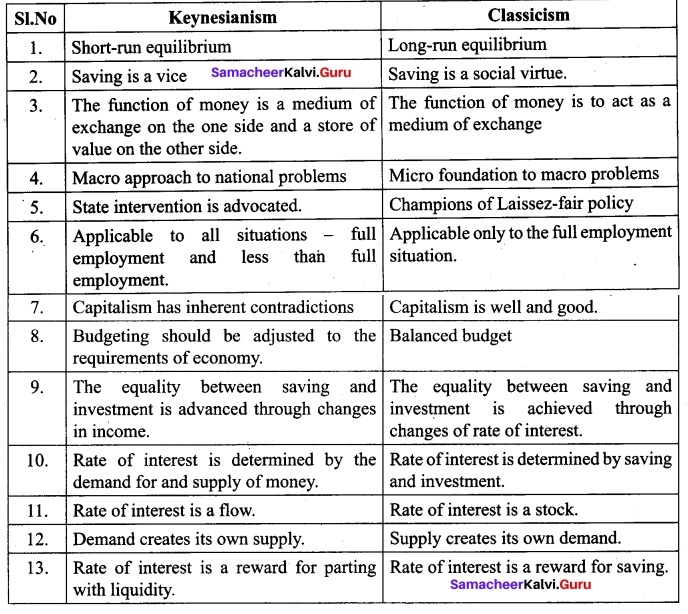
[OR]
(b) Explain the features of Keynesianism.
Answer:
- Short-run equilibrium
- Saving is a vice
- The function of money is a medium of exchange on the one side and a store of value on the other side.
- Macro approach to national problems
- State intervention is advocated.
- Applicable to all situations – full employment and less than full employment.
- Capitalism has inherent contradictions.
- Budgeting should be adjusted to the requirements of economy.
- The equality between saving and investment is advanced through changes in income.
- Rate of interest is determined by the demand for and supply of money.
- Rate of interest is a flow.
- Demand creates its own supply.
- Rate of interest is a reward for parting with liquidity.
Question 43 (a).
What are the differences between MEC and MEI?
Answer:
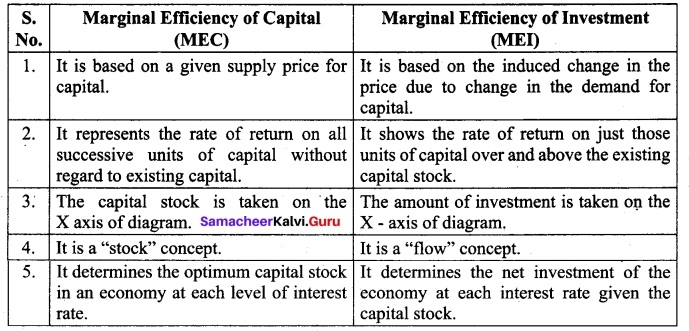
![]()
[OR]
(b) Describe the phases of Trade cycle.
Answer:
Phases of Trade Cycle:
The four different phases of trade cycle is referred to as
- Boom
- Recession
- Depression and
- Recovery.
These are illustrated in the figure.
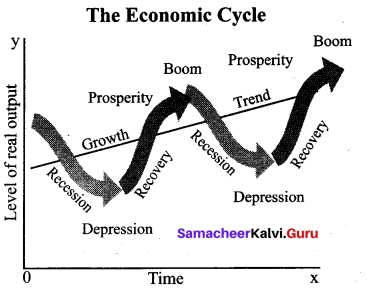
Phases of Trade Cycle The Economic Cycle
1. Boom or Prosperity Phase:
- The full employment and the movement of the economy beyond full employment is characterized as boom period.
- During this period, there is hectic activity in economy.
- Money wages rise, profits increase and interest rates go up.
- The demand for bank credit increases and there is all-round optimism.
2. Recession:
- The turning point from boom condition is called recession.
- This happens at higher rate, than what was earlier.
- Generally, the failure of a company or bank bursts the boom and brings a phase of recession.
- Investments are drastically reduced, production comes down and income and profits decline.
- There is panic in the stock market and business activities show signs of dullness.
- Liquidity preference of the people rises and money market becomes tight.
3. Depression:
- During depression the level of economic activity becomes extremely low.
- Firms incur losses and closure of business becomes a common feature and the ultimate result is unemployment.
- Interest prices, profits and wages are low. The agricultural class and wage earners would be worst hit.
- Banking institutions will be reluctant to advance loans to businessmen.
- Depression is the worst phase of the business cycle.
- Extreme point of depression is called as “trough”, because it is a deep point in business cycle.
4. Recovery:
- After a period of depression, recovery sets in.
- This is the turning point from depression to revival towards upswing.
- It begins with the revival of demand for capital goods.
- Autonomous investments boost the activity.
- The demand slowly picks up and in due course the activity is directed towards the upswing with more production, profit, income, wages and employment.
- Recovery may be initiated by innovation or investment or by government expenditure (autonomous investment).
![]()
Question 44 (a).
What are the functions of NABARD?
Answer:
Functions of NABARD:
NABARD has inherited its apex role from RBI i.e, it is performing all the functions performed by RBI with regard to agricultural credit.
(i) NABARD acts as a refinancing institution for all kinds of production and investment credit to agriculture, small-scale industries, cottage and village industries, handicrafts and rural crafts and real artisans and other allied economic activities with a view to promoting integrated rural development.
(ii) NABARD gives long-term loans (upto 20 Years) to State Government to enable them to subscribe to the share capital of co-operative credit societies.
(iii) NABARD gives long-term loans to any institution approved by the Central Government or contribute to the share capital or invests in securities of any institution concerned with agriculture and rural development.
(iv) NABARD has the responsibility of co-ordinating the activities of Central and State Governments, the Planning Commission (now NITI Aayog) and other all India and State level institutions entrusted with the development of small scale industries, village and cottage industries, rural crafts, industries in the tiny and decentralized sectors, etc.
(v) It maintains a Research and Development Fund to promote research in agriculture and rural development
[OR]
(b) Discuss the various types of disequilibrium in the balance of payments.
Answer:
Types BOP Disequilibrium:
There are three main types of BOP Disequilibrium, which are discussed below.
- Cyclical Disequilibrium,
- Secular Disequilibrium,
- Structural Disequilibrium.
1. Cyclical Disequilibrium: Cyclical disequilibrium occurs because of two reasons. First, two countries may be passing through different phases of business cycle. Secondly, the elasticities of demand may differ between countries.
2. Secular Disequilibrium: The secular or long-run disequilibrium in BOP occurs because of long-run and deep seated changes in an economy as it advances from one stage of growth to another. In the initial stages of development, domestic investment exceeds domestic savings and imports exceed exports, as it happens in India since 1951.
3. Structural Disequilibrium: Structural changes in the economy may also cause balance of payments disequilibrium. Such structural changes include development of alternative sources of supply, development of better substitutes, exhaustion of productive resources or changes in transport routes and costs.
Question 45 (a).
Explain the objectives of IMF.
Answer:
Objectives Of IMF:
- To promote international monetary cooperation among the member nations.
- To facilitate faster and balanced growth of international trade.
- To ensure exchange rate stability by curbing competitive exchange depreciations.
- To eliminate or reduce exchange controls imposed by member nations.
- To establish multilateral trade and payment system in respect of current transactions instead of bilateral trade agreements.
- To promote the flow of capital from developed to developing nations.
- To solve the problem of international liquidity.
[OR]
(b) Explain the scope of public finance.
Answer:
Scope of Public Finance:
The subject ‘Public Finance’ includes five major sub-divisions, viz., Public Revenue, Public Expenditure, Public Debt, Financial Administration and Fiscal Policy.

(i) Public Revenue:
Public revenue deals with the methods of raising public revenue such as tax and non-tax, the principles of taxation, rates of taxation, impact, incidence and shifting of taxes and their effects.
(ii) Public Expenditure:
This part studies the fundamental principles that govern the Government expenditure, effects of public expenditure and control of public expenditure.
(iii) Public Debt:
Public debt deals with the methods of raising loans from internal and external sources. The burden, effects and redemption of public debt fall under this head.
(iv) Financial Administration:
- This part deals with the study of the different aspects of public budget.
- The budget is the Annual master financial plan of the Government.
- The various objectives and steps in preparing a public budget, passing or sanctioning, allocation evaluation and auditing fall within financial administration.
(v) Fiscal Policy:
Taxes, subsidies, public debt and public expenditure are the instruments of fiscal policy.
![]()
Question 46 (a).
Mention the Comparison of Direct and Indirect taxes.
Answer:
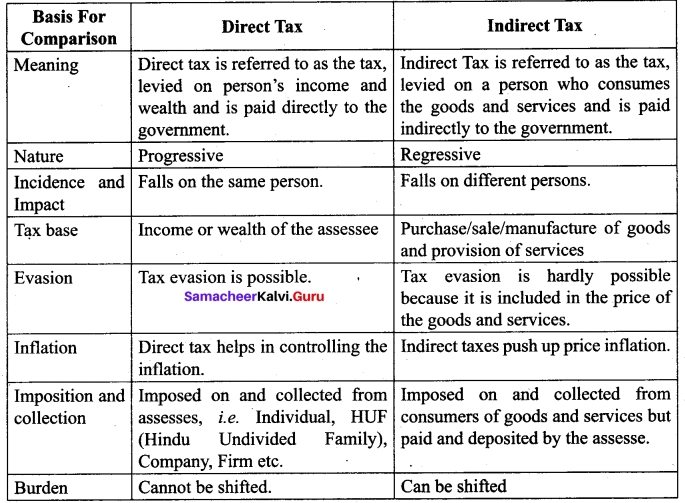
[OR]
(b) Write the limitations of statistics.
Answer:
Statistics with all its wide application in every sphere of human activity has its own limitations. Some of them are given below.
(i) Statistics is not suitable to the study of qualitative phenomenon: Since statistics is basically a science and deals with a set of numerical data. It is applicable to the study of quantitative measurements. As a matter of fact, qualitative aspects like empowerment, leadership, honesty, poverty, intelligence etc., cannot be expressed numerically and statistical analysis cannot be directly applied on these qualitative phenomena.
(ii) Statistical laws are not exact: It is well known that mathematical and.physical sciences are exact. But statistical laws are not exact and statistical laws are only approximations. Statistical conclusions are not universally true. They are true only on an average.
(iii) Statistics table may be misused: Statistics must be used only by experts; otherwise, statistical methods are the most dangerous tools on the hands of the inexpert. The use of statistical tools by the inexperienced and untrained persons might lead to wrong conclusions, (zv) Statistics is only one of the methods of studying a problem: Statistical method does not provide complete solution of the problems because problems are to be studied taking the background of the countries culture, philosophy, religion etc., into consideration. Thus the statistical study should be supplemented by other evidences.
Question 47 (a).
Explain the Environmental quality?
Answer:
- Environmental quality is a set of properties and characteristics of the environment either generalized or local, as they impinge on human beings and other organisms.
- It is a measure of the condition of an environment relative to the requirements of one or more species and to any human need. Environmental quality has been continuously declining due to capitalistic mode of functioning.
- Environment is a pure public good that can be consumed simultaneously by everyone and from which no one can be excluded.
- A pure public good is one for which consumption is non-revival and from which it is impossible to exclude a consumer.
- Pure public goods pose a freerider problem.
- As a result, resources are depleted.
- The contribution of the nature to GDP as well as depletion of natural resources are not accounted in the present system of National Income Enumeration.
![]()
[OR]
(b) What are the approaches to Economic Development?
Answer:
There are two main approaches to the concept of development viz
- the traditional approach and
- the new welfare oriented approach.
1. Traditional Approach:
- The traditional approach defines development strictly in economic terms.
- The increase in GNP is accompanied by decline in share of agriculture in output and employment while those of manufacturing and service sectors increase.
- It emphasizes the importance of industrialization.
- It was assumed that growth in GNP per capita would trickle down to people at the bottom.
2. New Welfare oriented Approach:
- During 1970s, economic development was redefined in terms of reduction of poverty, ‘inequality’ and unemployment within the context of a growing economy.
- In this phase, ‘Redistribution with Growth’ became the popular slogan.
- To quote Michael P. Todaro, “Development must, therefore, be conceived as a multidimensional process involving major changes in social structures, popular attitudes and national institutions as well as the acceleration of growth, the reduction of inequality and the eradication of absolute poverty”.